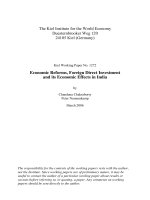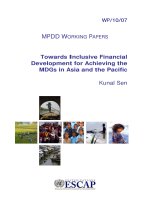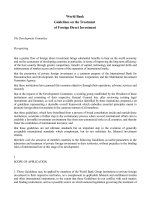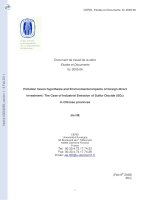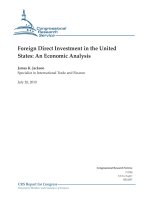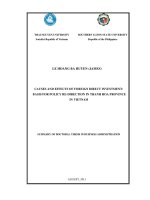Corporate links and foreign direct investment in asia and the pacific
Bạn đang xem bản rút gọn của tài liệu. Xem và tải ngay bản đầy đủ của tài liệu tại đây (42.97 MB, 319 trang )
Corporate Links and Foreign Direct
Investment in Asia and the Pacific
Corporate Links and Foreign
Direct InvestiDent in Asia
and the Pacific
edited by
Edward K.Y. Chen
and
Peter Drysdale
~ ~ ~~o~~~~~i~G~oup
New York London
in association with
The Pacific Trade and Development Conference Secretariat
The Australian National University
Centre of Asian Studies, The University of Hong Kong
First published 1995 by Westview Press
in association with
The Pacific Trade and Development Conference Secretariat
The Australian National University
Published 2018 by Routledge
711 Third Avenue, New York, NY 10017, USA
2 Park Square, Milton Park, Abingdon, Oxon OX14 4RN
Routledge is an imprint of the Taylor & Francis Group, an informa business
Copyright© 1995, 2002 Taylor & Francis
All rights reserved. No part of this book may be reprinted or reproduced or
utilised in any form or by any electronic, mechanical, or other means, now
known or hereafter invented, including photocopying and recording, or in any
information storage or retrieval system, without permission in writing from
the publishers.
Notice:
Product or corporate names may be trademarks or registered trademarks, and
are used only for identification and explanation without intent to infringe.
Copy edited by Beth Thomson
Index by Suzanne Ridley
Typeset by Minnie Reis
ISBN 13: 978-0-8133-8973-8 (pbk)
Contents---- -------
Tables
Figures
Participants
Preface
vii
X
xii
XVll
Introduction and overview
H adi Soesastro
2
Growth and decline in multinational enterprises: from
equilibrium models to turnover processes
Richard E. Caves
3
The interdependence of trade and investment in the
Pacific
Peter A. Petri
29
4
Subregional economic integration: Hong Kong, Taiwan,
South China and beyond
Yun- Wing Sung
56
5
Chinese capitalism in Thailand: embedded networks and
industrial structure
Gary G. Hamilton and Tony Waters
87
6
On the causes of low levels of FDI in Japan
Ryuhei Wakasugi
7
Japan's low levels of inward direct investment: causes,
consequences and remedies
Mark Mason
v
9
112
129
CoRPORATE LINKS AND FoREIGN DIRECT INVESTMENT
8
Multinational corporations and technology transfer in
Penang and Guadalajara
Juan J. Palacios
153
9
A study of the operations of Japanese firms in Asia: the
electrical machinery industry
Motoshige Itoh and Jun Shibata
187
10
Technological change, foreign investment and the new
strategic thrust of Japanese firms in the Asia Pacific
Denis Fred Simon and Yongwook Jun
203
11
The international procurement and sales behaviour of
multinational enterprises
Chia Siow Yue
227
12
Direct investment in low-wage and high-wage countries:
the case of Taiwan
Tain-Jy Chen, Ying-Hua Ku and Meng-Chun Liu
262
13
Summary of discussion
Gordon de Brouwer
Index
275
290
vi
Tables-------------- ----------
Table 3.1
Table
Table
Table
Table
3.2
3.3
3.4
3.5
Table 3.6
Table 3.7
Table 3.8
Table 3.9
Table 3.10
Table 3.11
Table 3.12
Table 3.13
Table 4.1
Table 4.2
Table 4.3
Table 4.4
Table 4.5
Measures of regional interdependence (two-way trade),
1938-92
FDI inflows, 1971-92
East Asian FDI stocks, 1988-92
Recent changes in FDI approvals, 1991-93
Distribution of inward foreign investment stocks by source,
1980-92
Distribution of inward FDI stocks
Effects of foreign production on trade
Sales distribution of Asian affiliates of Japanese and US
firms
Sales distribution of Asian manufacturing affiliates of
Japanese firms, 1988-92
Definitions and sources of variables
Determinants of trade/GOP ratios, 1988-90
Determinants of inward FDI/GDP ratios, 1988-90
Correlation of external linkages and protection
Basic economic indicators for Greater South China, 1992
Contracted FDI in China by source country, 1979-92
Hong Kong's trade involving outward processing
operations in China, 1989-93
Values, growth rates and market shares of Hong Kong's
exports, 1978 and 1993
Exports of Hong Kong firms operating in Hong Kong and
Guangdong by commodity, 1993
Vll
32
35
36
37
38
39
43
45
45
47
48
49
50
57
62
68
71
73
CoRPORATELINKs AND FoREIGN DJREcr INvEsTMENT
Table 4.6
Table 4.7
Table 6.1
Table 6.2
Table 6.3
Table 7.1
Table 7.2
Table 7.3
Table
Table
Table
Table
8.1
8.2
8.3
8.4
Table 8.5
Table 8.6
Table 8.7
Table 9.1
Table 9.2
Table 9.3
Table 10.1
Table 10.2
Table 11.1
Table 11.2
Table 11.3
Table 11.4
Taiwan's exports to Hong Kong and China, 1988-93
Taiwan's 'direct' and indirect trade with China, 1986-93
Changes in market parameters in the United States and
Japan,1975-91
Spearman's and Kendall's rank correlation coefficients
Regression coefficients of explanatory variables
Top 25 foreign-affiliated companies in Japan by reported
income, 1992
US exports to majority American-owned affiliates as a
percentage of affiliates' total sales, preliminary 1991
estimates
US exports to majority American-owned affiliates in Japan
as a percentage of affiliates' total sales, preliminary 1991
estimates
Structure of Malaysia's electronics industry, 1986 and 1990
Growth of factories in Penang' s industrial estates, 1980-93
Distribution of factories in Penang' s industrial estates, 1993
Employment structure of electrical/electronics industry
in Penang's industrial estates, 1993
Location of electronics factories in Penang' s industrial
areas, 1992
Major electronics products manufactured in Penang, 1992
Concentration of major exporting companies by state, 1990
Distribution of foreign affiliates of the Japanese electrical
machinery industry in Asia, 1993
Japan's exports to and imports from Malaysia of electrical
machinery, 1985 and 1993
Export pattern for parts made in Malaysia and Singapore
Location of Japanese FDI, 1988-92
Japanese firms manufacturing VCRs in the Pacific Rim
Share of foreign affiliates in total exports of East Asian
host countries
Export ratios of foreign and local manufacturing firms in
Singapore, 1991
Export ratios of foreign affiliates in selected East Asian
host countries
Measures taken by Japanese firms to cope with yen
appreciation
viii
77
78
119
121
124
134
144
145
157
158
159
161
161
163
172
189
197
199
214
217
230
231
232
236
TABLES
Table 11.5
Role of trading affiliates of US MNEs in exports of US
majority-owned affiliates in host countries, 1977, 1982,
1988 and 1989
Table 11.6 Purchases of Singaporean IPOs by source country
and destination, 1992
Table 11.7 Purchases of Singaporean IPOs by origin of IPO, 1992
Table 11.8 Sales, inputs and intragroup transactions: a comparison
of Japanese affiliates in the United States, the European
Union, Asia and the NIBs, 1990
Table 11.9 Procurement and sales of Asian affiliates of Japanese
firms, 1989
Table 11.10 Comparison of procurement and sales behaviour of
Japanese and US affiliates, 1980 and 1990
Table 12.1 FDI by Taiwan's leading 674 firms, 1986-91
Table 12.2 FDI in high-wage and low-wage countries of Taiwan's
leading674firms, 1986-91
Table 12.3 Single equation PROBIT estimates of FDI by Taiwanese
firms
Table 12.4 Bivariate PROBIT estimates of FDI
Table 12.5 Effect of FDI on performance, 1986 and 1992
lX
242
245
245
250
251
256
264
265
268
270
271
Figures-----------
Figure 3.1
Figure 3.2
Figure 3.3
Figure 3.4
Figure 6.1
Figure 6.2
Figure 6.3
Figure 6.4
Figure 6.5
Figure 6.6
Figure 7.1
Figure 7.2
Figure 7.3
Figure 7.4
Figure 7.5
Figure 7.6
Intensity of regional trade, 1938-92
East Asian FDI inflows relative to regional GDP, 1971-92
Effects on trade and balance of payments of $1 of FDI in
Thailand
Relationship between FDI and trade intensity
FDI in Japan: net inflow of foreign capital and FDI
notifications, 1970-92
FDI in Japan by sector, 1971-91
International comparison of FDI inflows, 1982-91
Sales of foreign firms as a share of Japanese sales, and
royalites paid by Japanese firms on foreign technology, by
industry
Technological advantage and share of local production of
foreign firms
Profit rates of Japanese and foreign firms in Japan's
manufacturing sector, 1985-90
US FDI position abroad: main hosts as of 1992
US FDI postion in Japan and other G-5 countries, 1980-92
US FDI position in Japan versus Japanese FDI position
in the United States, 1980-92
Principal source countries of FDI stocks in Japan as of
1992
FDI position in the United States, United Kingdom, (West)
Germany and Japan, 1983-91
FDI stocks in Japan by sector, 1992
X
33
36
44
46
113
114
115
121
122
126
130
131
132
132
133
135
fiGURES
Figure 7.7
Figure 9.1
Figure 9.2
Figure 9.3
Figure 9.4
Figure 9.5
Figure 9.6
Figure 10.1
Figure 10.2
Figure 10.3
Figure 10.4
Figure 10.5
Japanese mergers and acquisitions, 1981-92
Direct investment in Asia by Japan, the United States
and the European Union, 1987-91
Assembly process for automobiles and VCRs
Share of imported parts in output of Japan's home
electrical appliances industry, 1985-2000
Share of internal production of parts in home
electrical appliances industry, 1985-2000
Location of sales of automobiles and electrical machinery,
1984 and 1993; location of supply of automobile and
electrical/electronic parts, 1984 and 1992
Share of parts in Japan's total machinery exports by
region, 1993
FDI and the emergence of networks
Impact of the microelectronics revolution
Impact of the information technology revolution
NEC: networks, alliances and D&D in the Pacific Rim
NBC's PC business network
xi
141
189
191
193
194
198
200
205
208
210
219
220
Participants
Dr Florian A. Alburo
University of the Philippines,
The Philippines
Professor Edward K.Y. Chen
The University of Hong Kong,
Hong Kong
Dr C. Fred Bergsten
Institute for International Economics,
United States
Dr Po-Chih Chen
Taiwan Institute of Economic Research,
Taiwan
Dr Alan E. Bollard
Commerce Commission,New Zealand
Dr Tain-Jy Chen
Chung-hua Institution for Economic
Research, Taiwan
Mr Gordon de Brouwer
The Australian National University,
Australia
Dr Leonard Cheng
Hong Kong University of Science and
Technology, Hong Kong
Mr Javier Guzman Calafell
International Economic Affairs, Mexico
Professor Chia Siow Yue
National University of Singapore,
Singapore
Mr Giovanni Capannelli
Hitotsubashi University, Japan
Professor Richard E. Caves
Harvard University, United States
Dr Yun-peng Chu
Fair Trade Commission,
Republic of China
Dr Lawrence L.C. Chau
School of Economics and Finance,
United States
Professor Rolf D. Cremer
Department of Economics,
New Zealand
xii
pARTICIPANTS
Professor Wendy Dobson
University of Toronto, Canada
Dr Satish C. Jha
Asian Development Bank, India
Professor Peter Drysdale
The Australian National University,
Australia
Professor Yongwook Jun
Chung-Ang University, South Korea
Professor Dennis J. Encarnation
Harvard University, United States
Dr Mingsarn Kaosa-ard
Thailand Development Research
Institute Foundation, Thailand
Professor H. Edward English
Carleton University, Canada
Professor Kiyoshi Kojima
Suguradai University, Japan
Professor Carlo Filippini
Bocconi University, Italy
Professor Akira Kohsaka
Osaka University, Japan
Dr John Frankenstein
The University of Hong Kong,
Hong Kong
Professor Lawrence B. Krause
University of California, San Diego,
United States
Professor Ross Garnaut
The Australian National University,
Australia
Mr C.H. Kwan
Nomura Research Institute, Japan
Ms Ying-Hua Ku
Chung-Hua Institution for Economic
Research, Taiwan
Professor Gary Hamilton
University ofWashington,
United States
Professor Y. Y. Kueh
Lingnan College, Hong Kong
Dr Farid Harianto
University of Toronto, Canada
Ms P.K. Lau
Hong Kong Polytechnic, Hung Hom,
Kowloon
Dr Hal Hill
The Australian National University,
Australia
Dr Lee Tsao Yuan
Institute of Policy Studies, Singapore
Sir Frank Holmes
National Bank of New Zealand,
New Zealand
Mr Edward Leung
Hong Kong Trade Development
Council, Hong Kong
Mr Ralph Huenemann
University of Victoria, Canada
Dr K.W. Li
City Polytechnic of Hong Kong,
Hong Kong
Professor Motoshige Itoh
University of Tokyo, Japan
xiii
CORPORATE LINKS AND FOREIGN DIRECT INVESTMENT
Dr Justin Lin
Department of Rural Economic
Development, China
Professor Denis F. Simon
Tufts University, United States
Dr Hadi Soesastro
Centre for Strategic and International
Studies, Indonesia
Mr Meng-Chun Liu
Chung-Hua Institution for Economic
Research, Taiwan
Dr Devinda Subainge
World Bank, United States
Professor Mark Mason
Yale University, United States
Professor Corrado Molteni
Bocconi University, Italy
Dr Yon-Wing Sung
Chinese University of Hong Kong,
Hong Kong
Professor S.J. Nicholas
The University of Melbourne, Australia
Ms Tomoko Takahashi,
FAIR, Japan
Professor Mee-Kau Nyaw
The Chinese University of Hong Kong,
Hong Kong
Professor Moktar Tamin
University of Malaya, Malaysia
Dr Min Tang
Asian Development Bank,
The Philippines
Dr Juan J. Palacios
University of Guadalajara,
Mexico
Mr John Chun-Wah Tsang
Assistant Director General of Trade,
Kowloon
Dr Mari Pangestu
Centre for Strategic and International
Studies, Indonesia
Professor Shujiro Urata
Waseda University, Japan
Mr Steve Parker
The Asia Foundation, United States
Professor Ricardo Vicuna
Ministry of Foreign Affairs, Chile
Professor Hugh Patrick
Columbia University, United States
Professor Ryuhei W akasugi
Yokohama National University, Japan
Professor Peter A. Petri
Brandeis University, United States
Dr D.O. Wang
The University of Hong Kong,
Hong Kong
Mr Graeme Pirie
Asia-Pacific Economic Cooperation
Secretariat, Singapore
Mr Tony Waters
University of California, Davis,
United States
Mr Jun Shibata
University of Tokyo, Japan
xiv
PARTICIPANTS
Professor Maria Weber
Bocconi University, Italy
Dr Vladimir Yakubovsky
Visiting Fellow, Japan Centre for
Economic Research, Japan
Ms Anissa Wong
Industry Department, Hong Kong
Professor Ippei Yamazawa
Hitotsubashi University, Japan
Ms Teresa Wong-Kwong
The University of Hong Kong,
Hong Kong
Dr Soogil Young
Korea Transport Institute,
South Korea
Professor Wu Rong-I
Taiwan Institute of Economic Research,
Taiwan
Dr Zhu Naixiao
South China Normal University,
China
Dr Eugenia Yakovleva
Institute of World Economy and
International Relations, Russia
XV
Preface------------------------
The Asia Pacific economies have enjoyed high growth rates over the past several
decades. The East Asian 'economic miracle' began with Japan and was carried
forward with the export-oriented industrialisation strategies of the four little 'dragons' Hong Kong, South Korea, Singapore and Taiwan. It has come to encompass the other
East Asian economies, including China, over the last decade or so. The transmission
of economic growth throughout the East Asian region has been powerful.
One important mechanism for such transmission has been foreign direct investment. An earlier PAFTAD volume, Direct Foreign Investment in Asia and the
Pacific, explored the role of foreign direct investment in Asia Pacific development and
growth at the end of the 1960s. A number of other studies have examined the impact
of direct investment on the regional economy. However, there has been less research
on corporate strategies and firm-level behaviour in multinational corporate operations
in the region. For this reason, P AFT AD 21 chose to focus on corporate links and
foreign direct investment in Asia and the Pacific as its central theme.
This volume is a collection of the edited papers presented at the Twenty-First
Pacific Trade and Development (PAFTAD) Conference held in Hong Kong in June
1994. The Centre of Asian Studies, an integral part of the University of Hong Kong,
was very pleased to act as host for the conference. Despite the fact that Hong Kong
scholars have been participating in PAFT AD activities for a long time, this was the
first time that the conference was held in Hong Kong. We would like to express our
gratitude to the Hong Kong government for its most generous financial support of the
conference. In particular, thanks are due to Mr Brian T.H. Chau, Secretary for Trade
and Industry, for his assistance throughout the preparations for the conference. We
also thank the Governor of Hong Kong, Mr Christopher Patten, for his presence at the
conference and for officiating at the opening ceremony. His opening address was much
more than ceremonial, and contained a mixture of his personal insights and experience
relating to the issues discussed throughout the conference.
xvii
CoRPORATE LINKS AND FoREIGN DIRECT INVESTMENT
The PAFT AD Conference and this volume would not have been possible without
the consortium of funders from around the region. We are grateful to the Asian
Development Bank, the Asia Foundation, the Australian National University, the Ford
Foundation, the Kansai Federation of Economic Organisations, the Korea Development Institute, the Rockefeller Brothers Fund, the Taiwan Institute of Economic
Research and the Tokyo Chamber of Commerce for their continuing support for the
work of PAFT AD over many years.
We would like to acknowledge the efficient assistance provided by the PAFT AD
Secretariat in Canberra and the advice given by the International Steering Committee.
We are also very grateful to the local organising committee members, Dr Lawrence
L.C. Chau, Dr Sung Yun-Wing and Ms Teresa Y.C. Wong, for their hard work and
guidance. Credit also goes toMs Mely Caballero-Anthony, Conference Secretary,
who was responsible for overseeing the logistics of the conference preparations.
The volume was edited at the PAFTAD Secretariat at the Australian National
University. Ms Beth Thomson has done an excellent job in editing the original papers
for publication and Ms Minni Reis an equally fine job in designing and typesetting the
manuscript.
We trust that you agree that the volume makes a valuable contribution to
understanding of the role of foreign direct investment and corporate links in the
process of Asia Pacific economic development.
Edward K.Y. Chen and Peter Drysdale
November 1994
xviii
1
Introduction and overview-Hadi Soesastro
The setting
Some of the most interesting developments that have taken place in recent years in the
Asia Pacific region have been in the field of foreign direct investment (FDI).
Intraregional FDI flows have increased dramatically over the past 10 years or so. The
stock of FDI in the ASEAN countries excluding Brunei (Indonesia, Malaysia, the
Philippines, Thailand and Singapore) is estimated to have increased by about 14 per
cent annually in 1980-92. The average increase in the stock of FDI in China over the
same period was 15 per cent per annum. The rate of increase has been even higher in
recent years: about 25 per cent annually for 1988-92. In terms of approvals, reports
indicate that inward FDI flows to China increased sharply in 1993. This suggests that
there may have been significant diversions of investment to China from other
destinations, particularly the ASEAN countries. In the three Asian NIEs (Hong Kong,
South Korea and Taiwan) the rate of increase in the FDI stock was on average 22 per
cent per annum in 1980-92. The stock of FDI in the whole of developing East Asia
(China, the Asian NIEs, Indonesia, Malaysia, the Philippines and Thailand) may have
increased by as much as US$130 billion during this period.
Japan was, of course, the main source of FDI to developing East Asia. Based on
balance of payments data, during the period 1985-92 cumulative outward flows of
Japanese FDI amounted to about US$220 billion. The United States is still the main
destination of Japanese FDI, most of it in non-manufacturing activities. In contrast,
the bulk of Japanese FDI in East Asia continues to be directed at manufacturing
activities. In other words, East Asia has received a substantial share of Japan's total
direct investment in manufacturing.
Traditional sources of direct investment, namely the United States and Europe,
continue to be important for the East Asian region. There has also been a rapid increase
in new sources. The Asian NIEs' stock of FDI in East Asia, most of it in ASEAN
countries and China, increased by close to US$40 billion in 1980-92. This means that
about one-third of the total increase in the stock ofFDI in East Asia during this period
CoRPORATE LINKs AND FoREIGN DIRECT INvEsTMENT
originated from the Asian NIEs. A rise in cross-investment is another interesting
feature observed in the region. The stock of FDI from developing East Asia in the
United States could now amount to about US$10 billion, most of it of recent vintage.
Thus, the FDI picture in the Asia Pacific region is characterised not only by a dramatic
rise in the volume of direct investment, but also by shifts in the destinations and sources
of FDI flows.
The immediate issues that arise from this brief review are the sustainability of these
rates of increase, the pattern of distribution ofFDI flows across countries in the region,
and the likely implications of the changing structure ofFDI sources on trade and other
cross-border activities of the regional economies. The relevance of these questions,
from a regional point of view, rests on a recognition that FDI flows have been
responsible for the economic dynamism of the region and in particular the high rates
of growth experienced by developing East Asia. In addition, intraregional FDI flows
have contributed significantly to the deepening of regional economic interdependencies
and the market-driven integration of regional economies. However, in the political
economy realm, deepening of interdependence is not always good news. The creation
of regional production networks that could in turn alter the geo-economics of the Asia
Pacific region may have serious politico-security implications.
Direct investment flows in the region have been influenced by push and pull factors
that have changed over the years. Peter Petri in chapter 3 of this volume identifies four
waves of FDI flows into developing East Asia in the postwar period. The first wave,
which took place in the 1960s and early 1970s, was motivated by protected local
markets and the first major yen revaluation. Investment was concentrated mainly in
joint ventures in textiles and household electrical equipment. The second wave, in the
1970s, was spurred by the region's bright prospects and the availability of low-cost
capital. This wave of investment included import substitution projects in basic
industries and the creation of American export platforms in consumer electronics and
semiconductors. The third wave, involving the relocation oflabour-intensive industry
from Japan and the Asian NIEs to ASEAN, resulted essentially from the appreciation
of the yen and several NIE currencies in the mid 1980s. This push coincided with a
major pull: the significantly improved investment climate in ASEAN countries, which
boosted their export capacity.
The story of these first three waves, particularly the third, has often been told. It
is the fourth wave that will draw the attention of those interested in the region. Petri
identified this as involving a massive foreign investment boom in China. He thought
that it may be the most significant wave of investment yet in terms of its geo-economic
implications for the region. There is as yet disagreement as to whether this latest wave
of investment will cause a major diversion of investment, from the A SEAN region in
particular, as investors are attracted to China's huge domestic market. Should
ASEAN countries attempt to minimise the threat of diversion by introducing even
more liberal investment regimes? If this proves insufficient, what strategy should the
ASEAN countries adopt?
2
INTRODUCTION AND OVERVIEW
An alternative view suggests that this fourth wave may be characterised not so
much by a shift in destination as a major change in the origin ofFDI flows in the region.
This is seen in the increase in capital movements initiated by Overseas Chinese, as
manifested in FDI flows from the Chinese economies of Hong Kong and Taiwan. These
flows are not, however, going exclusively into China but to a significant degree into
ASEAN countries as well. Similarly, it can be argued that the main source ofthe FDI
boom in China could well be Japan.
Yet another scenario postulates that the fourth wave of FDI flows originated in
Japan and is undertaken for strategic considerations, but based on a product rather
than a market orientation. This scenario, proposed by Ken'ichi Imai at an earlier
Pacific Trade and Development Conference, suggests that the fourth investment wave
differs from the third in that it is driven, not by the major currency realignments of the
1980s, but rather by the globalisation of Japanese production activities involving new
cutting-edge technologies, such as fibre optics. These manufacturing activities on the
technological ascendancy curve can be undertaken outside Japan, but with Japan
retaining production of core technologies. As the ASEAN countries and China
continue to upgrade their technological capability, they will be able to participate in
such production networks, together with the Asian NIEs. This scenario sees both a
further consolidation of the East Asian regional production network with Japan at its
core and simultaneously an elevation of this network to higher technological levels,
thus giving support to the 'flying geese' paradigm.
Predicting what might constitute the fourth wave ofFDI necessarily involves some
speculation. However, in view of the possible significant longer term geo-economic
implications, this is both a useful and necessary exercise. Discussion at the TwentyFirst Pacific Trade and Development Conference provided important insights into the
major factors influencing the direction of changes in the nature and structure of FDI
flows in the Asia Pacific region.
The actors
Investment in the Asia Pacific region is undertaken by many investors, each acting on
the basis of some guidance or rules. An important feature of the region today is the
active involvement in cross-border activities, including FDI, not only of multinational
enterprises (MNEs) but also of small and medium sized enterprises from Japan or the
Asian NIEs. Firms from developing economies, such as the ASEAN countries, have
also entered the picture.
Richard Caves reminded the conference that transaction cost theory sees the MNE
as an economic agent that internalises decisions about resource allocation. Such
internalisation will be manifested in either a horizontally or vertically integrated firm
with activities that spill across national boundaries. To increase our understanding of
the behaviour of these actors, Caves suggests in chapter 2 that the process of gross
turnover of business units be examined more closely. Business units, he says, undergo
3
CORPORATE LINKS AND FOREIGN DIRECT INVESTMENT
processes of birth, expansion, contraction and demise. It has been observed, among
other things, that in manufacturing industries infant mortality rates are high, but that
there is a correlation between the rates of entrance and exit of firms.
This raises the question of the adaptability of business units to a changed
environment, and whether the capability to transform differs across cultures, countries
or regions, or sectors. In response to adverse changes in the environment, it has been
observed that subsidiaries ofMNEs do often restructure and change their roles, rather
than opting for exit. Anecdotal evidence was also given about the greater stability,
even in bad times, of Thai-Japan joint ventures compared with, say, Thai-Taiwan
joint ventures.
In chapter 12, Tain-Jy Chen et al. examine the direct investment patterns in highwage and low-wage countries of Taiwan's larger firms. As might be expected,
Taiwanese FDI in low-wage countries, such as Thailand, is undertaken mainly for
defensive purposes, namely to cut production costs and restore the firm's competitiveness in the export market. FDI in high-wage countries, on the other hand, is primarily
for the purpose of expanding markets. It is interesting to note the extent to which the
behaviour of large Taiwanese firms has not been significantly influenced by government policy, particularly with respect to locational decisions.
MNEs and other business units constantly make investment decisions in conditions
of uncertainty. Multinational corporations use their proprietary assets to compensate
for the uncertainty of the environment in which they operate. Although the imputed
value of a firm's proprietary assets may itself suddenly change, it has been observed
that MNEs are more likely to be risk takers than other business units. In contrast, small
and medium sized enterprises, which are much less able to spread risks, may simply
follow others in their investment location decision. The large-scale migration of
Japanese small and medium sized enterprises - the supporting industries - to
Thailand in the late 1980s essentially followed the successful relocation there earlier
on of their subcontractors. At an earlier Pacific Trade and Development Conference,
Paul Krugman pointed to the importance of this demonstration effect. The 'new
economic geography' would also predict why such clustering or agglomeration
occurs. Still needing explanation, however, is why this has not equally been the case
in Indonesia. Specifically, why has not Indonesia been able to attract investment by
small and medium sized enterprises?
The emerging networks
The case of Greater South China, described so well by Yung-Wing Sung in chapter4,
provides one example of a subregional cluster. It involves investment, mainly in
Guangdong, by small and medium sized enterprises from Hong Kong and, to a lesser
extent, Taiwan. In fact, a very large proportion of Hong Kong's total FDI in China is
in Guangdong, most likely due to proximity and cultural factors. This subregional
production network is definitely market driven, and has developed in response to
China's policy of opening up its economy. It remains to be seen whether this situation
4
INTRODUCTION AND OVERVIEW
can be replicated elsewhere in the region and how effectively the clustering of
economic activities can be influenced by policy. The 'growth triangles' of the A SEAN
region- SIJORI (involving Singapore, Johor in Malaysia and Riau in Indonesia),
IMT (Indonesia, Malaysia and Thailand) and EAGA (the East ASEAN Growth Area,
involving eastern Malaysia, southern Philippines, Brunei and eastern Indonesia)were initiated (or sponsored) by governments, basically to attract FDI. The success of
the growth triangles in achieving this goal will depend on whether the complementarities
that exist among their constituents produce locational advantages.
The A SEAN Free Trade Area (AFT A) is also intended to attract investment flows
to the ASEAN region as a whole. While the movement of goods has become less
constrained, factors cannot as yet move freely. It is hoped that a larger, single, freer
ASEAN market will allow greater economies of scale to operate. Within the region,
the distribution of FDI will be affected by the way in which investors perceive
differences in comparative advantage among the A SEAN countries. The new patterns
of division of labour emerging in the ASEAN region are a part of those developing in
the wider Asia Pacific region.
In chapter 9, Motoshige Itoh and J un Shibata study the emerging division of labour
and operations of Japanese firms in the Asia Pacific region, focusing on the electrical
machinery industry. This industry, while dynamic, has special characteristics that
make it more suited to the globalisation of production than other industries. The impact
of the emerging division of labour on the operations of Japanese firms in other
industries therefore remains inconclusive at this stage.
In the production of VCRs, for example, the parent firm is usually involved in a
number of production and assembly stages. This would suggest that the business
network will be dominated by the parent company. In the automotive industry, on the
other hand, the parent firm is usually involved only in the production oflarge parts and
final assembly. This opens the possibility for firms to develop partnerships or other
types of strategic alliances. Gary Hamilton and Tony Waters argue in chapter 5 that
although the organisational modes in the automotive sector have evolved from an
internalised structure to global networks, the parent firm retains control of the links
in the production chain because the network is producer rather than buyer driven. Even
within the electrical machinery industry, different types of corporate links or business
networks can develop, suggesting that corporate links may not be as sector specific as
previously thought. They may be specific to the operations of the 'network firm', that
is, the firm that manages and coordinates the network. This will need to be substantiated by further research.
While modes of operation may vary, Denis Fred Simon and Jun Y ongwook are of
the opinion that Japanese firms investing abroad do in general have a common strategic
objective: the creation of regional sources of competitive advantage that will strengthen
their position both in the international marketplace and at home. They argue in chapter
10 that Japanese firms have increasingly come to view their counterparts in many
Asian economies as actual or potential partners. This indicates that the development
and consolidation of regional production networks by Japanese firms is likely to
5
CORPORATE LINKS AND FOREIGN DIRECT INvESTMENT
continue. Simon and Jun give a number of interesting examples ofthe various kinds
of business networking engaged in by Japanese firms.
Networking can be of the internal or external kind. Internal networking is
undertaken when control, usually through ownership, is considered important. External networking refers to the use of 'bonding' mechanisms of a non-equity type, such
as licensing, supplier or original equipment manufacturer (OEM) contracts, subcontracting, or strategic alliances. The different network structures can be either functionally based (through marketing or manufacturing) or even culturally linked. In the more
competitive and uncertain environment in which firms operate today, networking
enables companies to enhance constantly their access to complementary assets and
partners with high value-added.
This trend has a number of possible implications. Some see the emergence of two
major production and business networks in the Asia Pacific region, one Japanese and
the other Chinese. The latter refers to the cross-border production linkages formed by
Overseas Chinese capital, especially with mainland China. Although any Japanese
network will most likely be based on technology, it is much more difficult to define the
basis of a Chinese network. The notion of a community of Overseas Chinese linked by
culture is questioned, especially by the younger generation of Southeast Asians of
Chinese ancestry .It can be argued that within each society Overseas Chinese are likely
to have a sense of common identity based on their minority status. It is also apparent
that particular business practices attributed to the group are often not clearly
formulated or transparent, although in practice they seem to have worked well. It has
often been suggested that Chinese networks are essentially based on trust. Alternatively, however, they may be based on forms of financial relations.
Further, more precise study is needed to determine whether Japanese or Chinese
business networks in the Asia Pacific region are unique to that region or, indeed,
unique to Japan and China- if they exist at all as distinct entities. It is also unclear
whether these networks have changed over time. There are no compelling reasons to
predict that these two major networks are bound to collide with each other. Japanese
direct investment in East Asia is not at present concentrated in Southeast Asia, and will
probably be directed to China in increasing amounts; a significant amount ofFD I from
Hong Kong and Taiwan, meanwhile, continues to flow into ASEAN. What we may be
seeing is the emergence of two layers of regional production networks, with that of
Japan having a higher technological content.
Implications for trade and beyond
The changing nature of direct investment in the Asia Pacific region and the emergence
of production networks are believed to have an impact on trade. Petri shows that there
is a virtuous circle of investment, trade and growth in the region. The basis for this
observation is that outward-oriented trade and investment policies have stimulated
trade and attracted FDI, in turn encouraging governments to sustain policies that are
favourable for international linkages.
6


